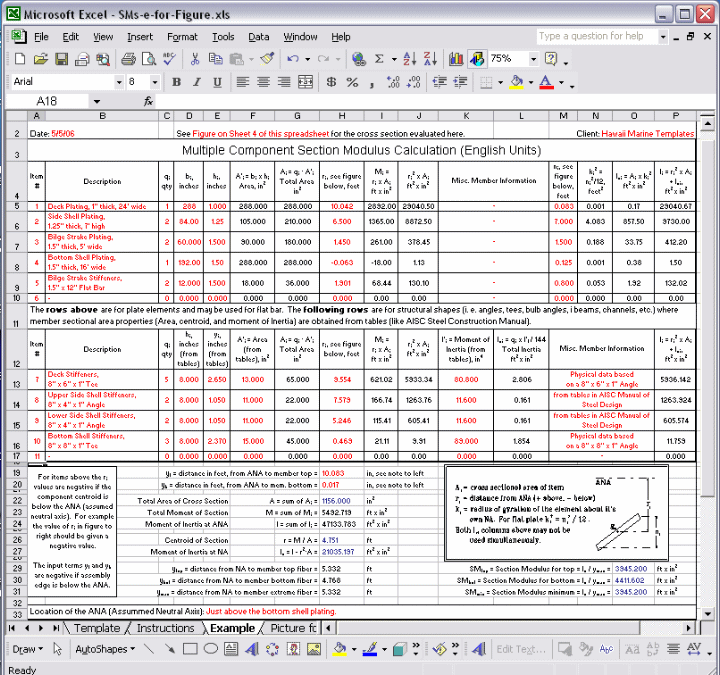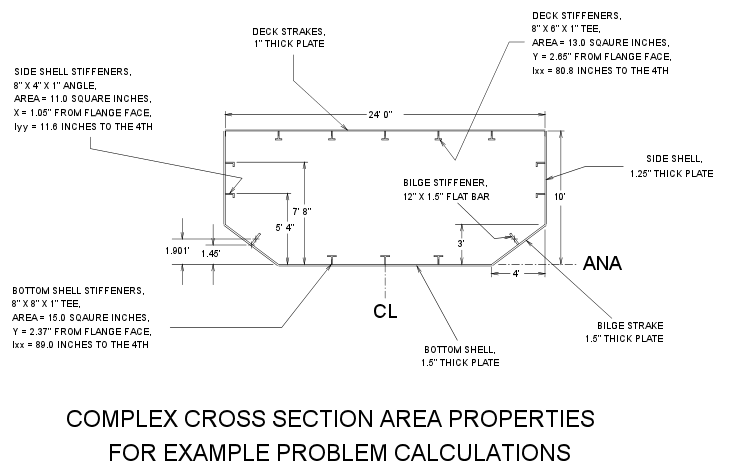|
| Download Now | Inputs/Outputs | Usage Terms |
| View Sample | System Requirements | Return to Index |
Description Computes cross sectional area properties of a complex framing member, like a ship or boat cross section, made up of a numerous components (Like a tees, angles, and flat bars that placed on various pieces of plate). Area properties from this sheet can be used as a part of the process utilized to obtain flexural stress, average shear stress and deflection.
Electronic Document Type: Microsoft Excel spreadsheet Cost: $32.00 US funds
Number of Pages: single sheet
-
overall depth of framing member (for all components combined)
-
location of assumed neutral axis ANA (perpendicular to loading direction)
-
For each Option One Component (flat bar or plating components) the following are required: description, cross section dimensions, distance to centroid from ANA, radius of gyration for convenience the method of obtaining this dimension is shown in a diagram on the spreadsheet. The spreadsheet actually contains fifteen rows to accommodate fifteen Option One components. With proper understanding the user may add additional rows if necessary. Note that the example below only shows 6 rows.
-
For each Option Two Component (tees, angle irons, channels, i beams, tubing, round bars or similar sections) the following are required: description, cross sectional area, distance to centroid (for determining distance to ANA), moment of inertia about own centroidal axis. The last three datum are normally obtained from a tables, like those contained in the A. I. S. C. Manual of Steel Construction. There are 20 rows to accommodate twenty Option Two members. An experienced Excel user may add more rows when required. The example below only contains 5 rows.
Outputs:
-
total cross sectional area
-
distance from cross sectional area centroid to the ANA
-
moment of inertia of the complex cross section
-
section modulus of the complex cross section
Items Included with the Product:
A blank template for you to input data.
-
A set of instructions on how to perform the analysis.
-
A sample calculation already filled out. It is recommended that each cell within the sample calculation be examined to fully grasp the techniques involved.
-
A drawing of the sample cross section .
-
A sheet containing the products standard "Use Terms."
Suggested Reading or References:
any strength of materials text
Basic Ship Theory, Rawson and Tupper
-
A. I. S. C. Manual of Steel Construction
Terms: Prior to purchase, read our End User License Terms.
Important Notice to European Union Buyers: Due to changes in international law, we no longer accept purchases from any individuals located within an EU country. However, businesses located within the EU are allowed to make purchases, provided that they make the VAT payments for any imported items purchased electronically. These EU businesses must specify their VAT number in the memo section on the Paypal payment pages. These changes are effective as of July 1, 2008, and were modified for EU businesses on April 9, 2010.
Download Now: Click one of the following buttons to pay. After payment you will be taken directly to the download page.
Minimum System Requirements: Windows 95/98/NT/2000/XP/Vista/Windows7
Customer Comments Regarding Similar Template: Go to feedback page, click here.
Sample: A sample calculation and cross section are shown below.


|


